Suggestions how to improve photography of Maya carved stelae and altars
When I first began photographing at Yaxha (circa 1970), we used the same basic equipment as most Maya archaeology projects: the reflectors you buy in any hardware store for a few dollars.
And normal incandescent bulbs (probably about 200 watts each).
It takes about four of these units to illuminate a stela. We used a Leica and a Hasselblad camera in those days; with Zeiss lenses for the Hasselblad. So at least our camera equipment was professional (but the lighting equipment was pathetic).
40 years later we have enough experience to realize you need professional lighting
Every decade after Yaxha we improved our lighting equipment. By the late 1970’s we had Lowel Tota-lites (still have them today; they last a half century without falling apart). By the 1990’s we upgraded to Lowel Rifa lights (currently they are called Rifa eXchange System). We also used Lowel Omni-light system for decades.
We like all these Lowel lights and find the owner and staff at Lowel very knowledgeable and hospitable in their booth at major camera equipment expos such as PhotoEast.
We added Dedolights too, but they did not work with tri-linear scanning backs
Dedolights are outstanding for lighting small figurines and other small sized archaeology artifacts. But these lights fluctuated too much so were not usable with tri-linear scanning backs such as Better Light. So we do not use Dedolights much any more. But if you are a museum or large and long-range archaeology project they are worth trying.
Then we evolved to Fluorescent studio lighting
We first tried fluorescent lighting from a French company. But there was no way to aim them at an artifact: these lights were originally made to secure overhead in a TV studio. So we do not use these any more. Plus the people we knew here left the company long ago.
The offices of FLAAR were at Bowling Green State University in Ohio for about five years and during this time we became more aware of the fluorescent lighting of F. J. Westcott, whose offices are in nearby Toledo, Ohio. So we gradually evolved our lighting style away from Dedolights and other tungsten halogen, and away from the French fluorescent lights over to Westcott Spiderlites.
When we do photography of Maya sculpture at Copan, we donate the photographs to the IHAH and to the local Copan Ruinas park. Indeed for many years the government of Honduras used our photos to showcase the beauty of Copan in posters by the tourist department.
Nowadays we use only digital cameras. Hasselblad for medium format film 40 years ago was great when the cameras were made in Sweden, with lenses made in Germany. Today the cameras are made by a company in Asia and the lenses are no longer Zeiss Made in Germany. As a result Phase One has surpassed the quality (for lenses; their camera is based on Mamiya and thus also made in Japan). So we use a new Phase One digital back on a 30-year old Hasselblad ELX made in Sweden. This way we get the best technology (and Zeiss lenses made in Germany).
Phase One has by far the better software (Capture One). Leica never understood that it takes more to create a great digital camera than just their brand name, so I have not bothered to use a Leica for over 20 years. A Nikon or Canon digital camera body has better options than a Leica nowadays (though most Nikon lenses made in Thailand vary from low bid cheap junk to fall-apart-within-months). But Nikkor lenses made in Japan are acceptable, as are Zeiss lenses (which curiously are no longer made in Germany!).
In summary: what counts in high resolution photography is the camera processing software (the “firmware”). It helps to have a good lens and good camera body but a Canon or Nikon with their firmware is better than Leica camera and Leitz lens since this company probably outsources their software (probably does not do it in-house). Firmware is like a web site, it can’t just be written like a book and published; firmware must constantly be tweaked and improved.
And, no matter how good your camera and lens, it helps to have good lighting.
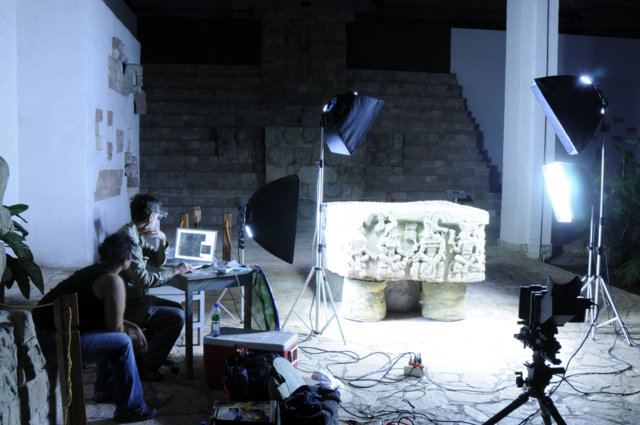 |
|
Photography Equipment at Copan
|
Tri-linear scanning back: large-format digital camera technology: Better Light.
Here we show photos of Altar Q of Copan, Honduras, taken with a large-format tri-linear technology, courtesy of BetterLight. Lens is either Schneider or Rodenstock. This photography session was about 5 years ago.
We photographed each side and then the capable graphic designers at FLAAR Mesoamerica stitched the four sides together.
If we were to re-take these photos today, we would suggest a medium format Leaf or Phase One digital back, with a Schneider lens.
The lighting can be the same with any digitial camera back technology: soft fluorescent lighting from F.J. Westcott (SpiderLite). We used SpiderLite TD4; we would suggest F.J. Westcott SpiderLite TD5 (we do not yet have the TD5 system).
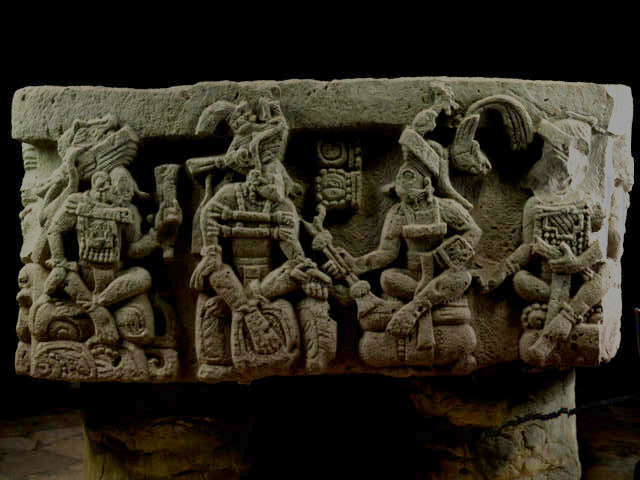 |
|
Honduras, Copan Altar Q ( side 1)
|
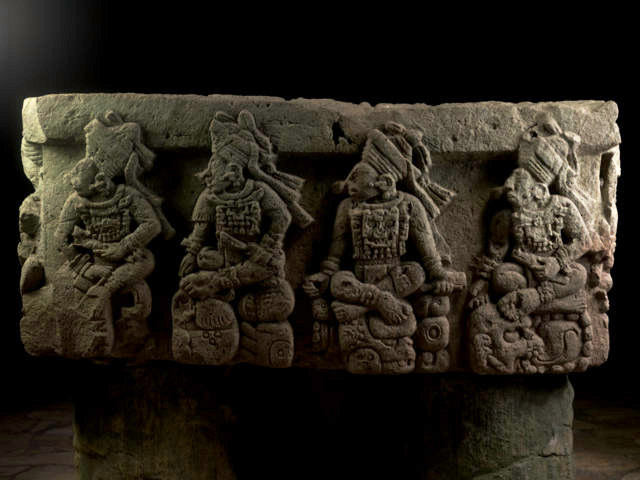 |
|
Honduras, Copan Altar Q ( side 2)
|
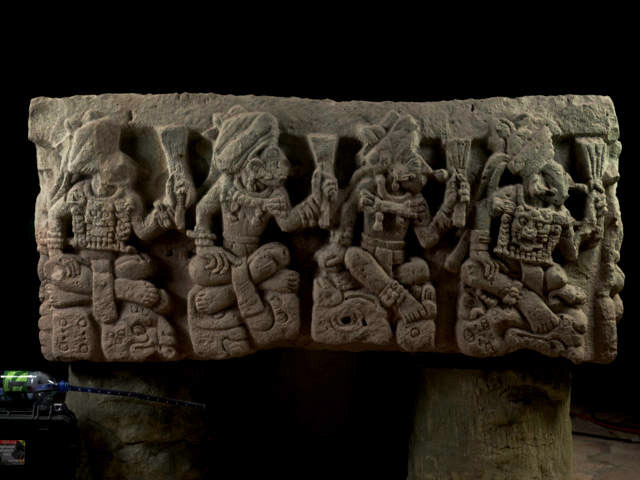 |
|
Honduras, Copan Altar Q ( side 3)
|
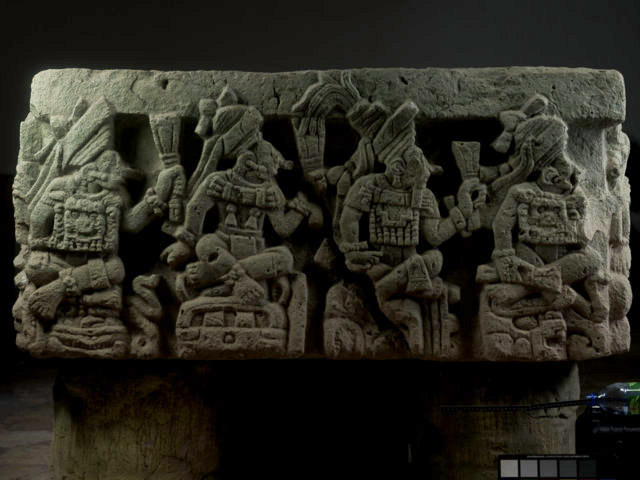 |
|
Honduras, Copan Altar Q ( side 4)
|
Why not use tungsten halogen lighting such as Lowel?
I have used Lowel Totalites for decades, including at Copan Ruinas museums. But the museum is huge and there are no outlets near the stone sculptures. So you have to have several hundred meters of electrical cords.
Plus, most museums do not have enough power to supply electricity to four tungsten halogen lights. So using tungsten halogen lighting is not effective if you need four lamp fixtures (which is what produces the best lighting; for a tall stela you will achieve the best results if you have six to eight lights; three on each side and two above). We do not have that many fluorescent fixtures yet, and we still need taller light stands. Avenger are very good, as are Matthews brand. (MSE Matthews Studio Equipment).
Select good light stands; Avenger and Matthews are the best
If you need to hold a light with a large softbox, you do not want to use a normal lightstand (they are too easy to fall over). Avenger and Matthews, with their three L-shaped foot supports, are by better by far. We tend to use Avenger since we tend to prefer products from Manfrotto Distribution company (Gitzo tripods, Manfrotto tripods, Metz flash, etc).
It is not easy to situate lighting in a museum, since the #1 rule is naturally not to harm the artifact. What would have helped would have been scaffolding out in front of the altar, so we could have had lighting from above. My style would be to have this lighting come at an angle (diagonal), so not merely pointing straight down).
But we had many sculptures to photograph, so no time to put up scaffolding. But now we have an extremely high-resolution photograph of each of the four sides.
Plus, if you put the four sides together in a straight line, you can see the 16 kings of Copan over a thousand years ago, rendering homage to the founder of their dynasty.
Summary on tips for photography in museums
We use only Gitzo tripods; some have lasted several decades. Not one has ever fallen apart (note that we use only the top-of-the-line Gitzo models).
We use a 30+ year old original Arca-Swiss ballhead. Their next model was as poorly engineered and badly constructed as the first one was brilliantly engineered and impressively constructed.
Westcott Spiderlite TD4 is what we have; we recommend these but would suggest moving to Spiderlite TD5, which we will evaluate as soon as we can receive a set (we use a set of four units).
We would like to evaluate LowelScandles. I note that Lowel Rifa exchange System can handle fluorescent or tungsten halogen. I would like to learn more about Lowel SOFTCORE system. And I would definitely like to learn more about Lowel GL-1 Power LED system. Would be great to have two of these (I can see their usefulness photographing leaf-cutting ants who occasionally cut flowers instead of leaves out in the remote rain forests of Guatemala).
And we definitely need to have taller Avenger light stands as well as lower Avenger light stands, since we wish to do more photography of Maya stelae. It can take up to 8 lights to illuminate a really tall monument.
 |
|
Honduras, Copan Altar (Rollout)
|
First posted June 6, 2014.






























